Our 10 Rocky Mountain National Park Boondocking Spots are all within 20 min. of the main entrance. But, you can be much closer using one of the other 4 entrances.
Rocky Mountain National Park was founded in 1915 and is located in Northern Colorado close to the Estes Park and Grand Lake towns in the US. There are many Rocky Mountain National Park boondocking spots. Wildlife in the mountain environments include wildlife like the marmots and mountain goats are protected here. This park has an area of 415 square miles and hiking trails of approximately 300 miles. If you want a destination of great fun, Rocky Mountain National Park should be on top of your list.
History of the Mount the Rocky Mountain National Park
The meadows and peaks in Rocky Mountain National Park were shaped by massive glaciers. Human beings started venturing into the valleys and mountains of this park about 11,000 years ago with the Utes tribe dominating the park until the late 1700s. The US government purchased the area in 1803 and it is later on that the name became Rocky Mountain, National Park.
Want more ideas to round-out your trip to Colorado?
A lot of great ideas are in these posts!
- 14 Great Sand Dunes National Park Boondocking (Updated 2022)
- 16 Browns Canyon Monument Boondocking (Updated 2022)
- 16 Colorado National Monument Boondocking (Updated 2022)
- 23 Canyon of the Ancients Boondocking (Updated 2022)
- 17 Black Canyon of the Gunnison Boondocking (Updated 2022)
- 110 Top Rocky Mountain National Park Boondocking (Updated 2022)
- 16 Hovenweep Monument Boondocking (Updated 2022)
- Best Rocky Mountain National Park Campgrounds 2022
- 9 Great Castlewood Canyon State Park Boondocking Sites
- 351 Free Colorado Boondocking Locations Along With Maps
- The 15 Best Rocky Mountain National Park Trails 1,2 or 3 Miles
It is in 1915 that the lodge keepers started to maintain roads within the park as well as building trails and guiding visitors. Later on, museums, well-maintained trails, and comfort stations were built by rangers to meet visitors’ expectations. The Trail Ridge Road was built in the 1930s by the National Park Service.
The visitation in the park grew steadily, decreased during World War II, and then started to increase again. The management before was not that efficient but today the park is being managed well by an interdisciplinary staff that consists of education rangers, carpenters, biologists, resource specialists, law enforcement rangers, administrators, carpenters, and engineers.
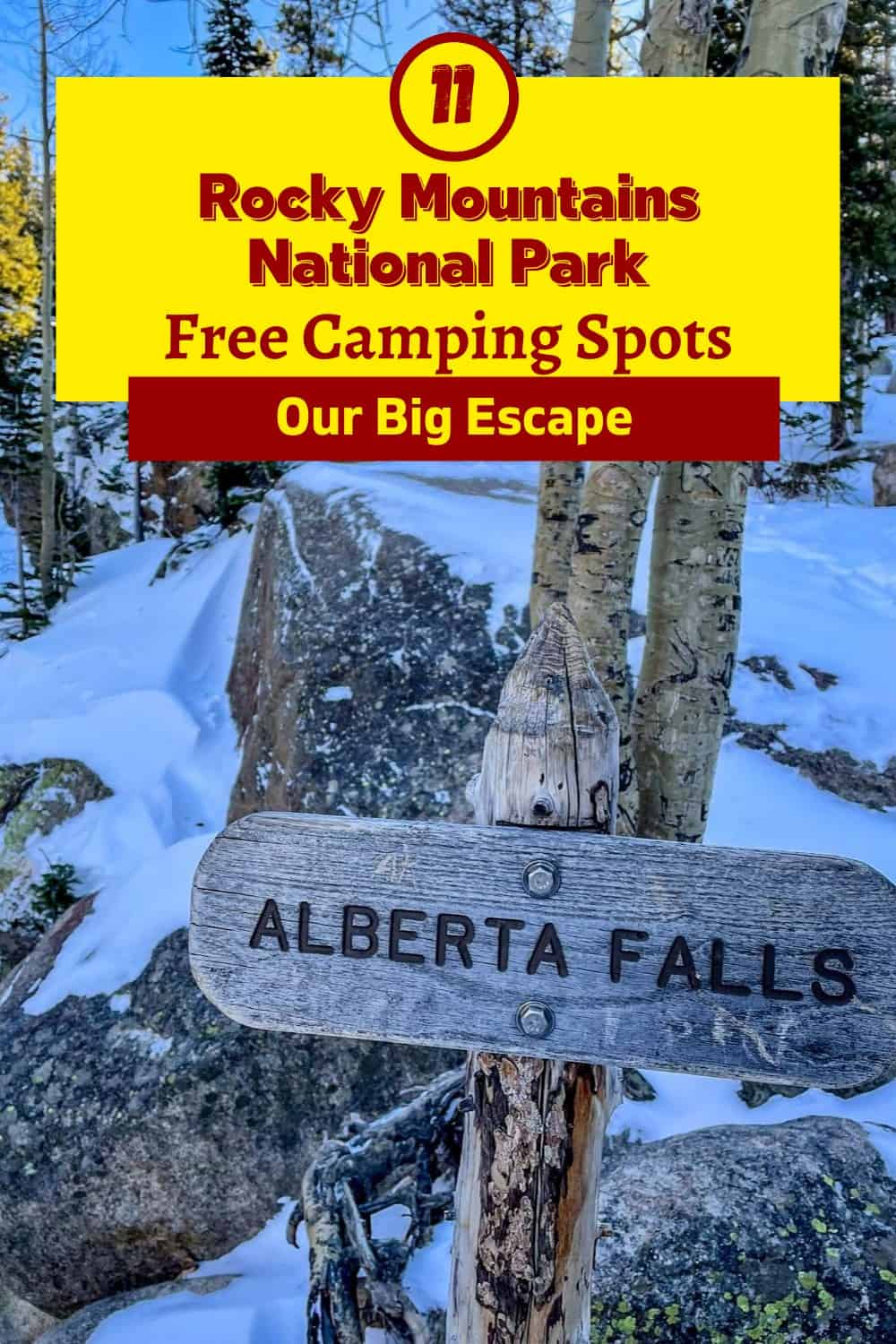
10 Top Rocky Mountain National Park Boondocking
check out our video
1. Rocky Mountain National Park – Dispersed Camping Along Coyote Hill Rd
Address
Estes Park, Colorado
GPS: 40.318012, -105.489219
Management: Coyote Hill Road Managed By: Forest Service
Free dispersed camping sites along Coyote Hill Road -> First camped No Reservations.
Best Review:
4×4 is definitely recommended, but I have seen a few 2wd who must have gone very slow. The road is pretty insane at points but there’s quite a few places to stay. The best spot has got to be the first pull out on the left as you get onto the rough road, most of the camping spots are in the trees. Very peaceful
2. Rocky Mountain National Park Boondocking Locations – Dispersed Camping on Hell Canyon Rd
Address
Estes Park, Colorado
GPS: 40.343565, -105.428001
Elevation: 7933′
Management: Public – Forest Service (Official)
Free dispersed camping sites along Coyote Hill Road -> First camped No Reservations.
Best Review:
The drive up is pretty rutted an steep. I made it up in a 2wd Dodge Ram. I’d definitely recommend high clearance but a 4wd Subaru or something could probably make it too with some maneuvering. I didn’t see many spots around and the views were nice but hidden behind trees. The site is fairly close to the East side of RMNP. Would not go up here if it has rained recently!
3. Rocky Mountain National Park Free Campsites – Stillwater Pass Dispersed
Address
County Highway 4
Grand Lake, Colorado
GPS: 40.21805, -105.887141
Elevation: 8724′
Management By: National Forest Service
Free Dispersed camping in the Arapaho and Roosevelt National Forests Sulphur Ranger District. First come -> first served. No reservations accepted. This is a high elevation location.
Best Review:
Loves this place. Stayed here first weekend in August 2018. Instead of boondocking on CR4 we took road 455 off CR4. Much more room for larger rigs although we only had a 30ft TT. We found a nice large area that could easily hold several rigs but we we’re the only camper for the weekend. Has some nice walking trails to take advantage of and saw some deer and lots of hummingbirds.
4. Rocky Mountain National Park Free RV Parking – Stillwater Pass
Address
County Highway 4
Grand Lake, Colorado
GPS: 40.225518, -105.909384
Elevation: 8645′
Managed By: National Forest Service
Trailhead featuring access to extensive motorized trail system known as Stillwater Pass and Grand Lake trail system. Facilities include restrooms and information kiosk.
Biking: Mt. Biking on motor vehicle used roads and trails. Share the road with motorized vehicles.
Directions: Take Highway 34 to County Road 4. Turn left and go approximately 4.5 miles to the trailhead.
Best Review
Really beautiful aspen groves, and pretty dense if you hike into the woods a bit, but *BEWARE* these sites are very popular for two things: Off road vehicles and guns. During our weekend stay here, the ATV, dirt bike and RV traffic was a constant, slowing down only at night. As early as 9:00AM other campers also began shooting guns into the forest for considerable lengths of time. Do not choose this campground if you’re looking for a more isolated and quiet dispersed camping experience.
5. Rocky Mountain National Park – Parachute Hill Rd.
Address
Allenspark, Colorado
GPS: 40.2373, -105.47993
Elevation: 8681′
Managed By: National Forest Service
The road in is 4×4. Parachute Hill Rd. is open Year Round. There are 1-5 campsites at this location. You may stay 14 days at Parachute Hill Rd. Dispersed camping in Roosevelt National Forest, near Rocky Mountain National Park. No gates and open year round. 4WD required. Very close to Johnny Park Rd, where additional dispersed camping can be had except during the winter.
Best Review:
Campsites were pretty cool, but needing high clearance is an understatement. The road is extremely rough and either an overland rig or trail driving knowledge is required in order to reach any campsite other than the first one. No service on the way in so my suggestion is to just not turn up the hill and keep going on Johnny Park Rd to find the better sites.
6. Rocky Mountain National Park Boondocking Locations – Johnny Park Road Dispersed Camping
Address
Johnny Park Road (FR 118)
Allenspark, Colorado
GPS: 40.228339, -105.473236
Elevation: 8422′
Managed By: National Forest Service
The road in is Dirt. You may stay 14 days at Johnny Park Road Dispersed Camping. Free Dispersed camping in the Arapaho and Roosevelt National Forests Canyon Lakes Ranger District. This is a seriously beautiful area not too far from Allenspark. First come -> first camped. There are no services. Bring all that you’ll need and pack it out when you leave. No reservations are accepted. This is a high elevation location. To reach this camping area, 4 wheel drive and high clearance are suggested. Campfires area permitted except when seasonal restrictions are in effect.
Best Review:
I enjoyed it a lot! I’d recommend driving all the way up the road if your car/truck can make it. While driving down there were two other sites I noticed who stopped before the road got really rocky. I chickened out and set up camp about 0.6 miles down hill from the end, then ended up walking up the rest of the way and was astonished by the views, especially during sunrise. I drove an AWD SUV. It was my first time up a mountain road like this.
7. Rocky Mountain National Park Free Campsites – Pole Hill Road
Address
Pole Hill Road
Drake, Colorado
GPS: 40.36632, -105.41992
Elevation: 8635′
Managed By: National Forest Service
Free, dispersed camping in the Roosevelt National Forest’s Canyon Lakes Ranger District. A great place to get in touch with nature. 4×4 high clearance required! No services. You’ll need to pack everything you need (water, food, toilet) in and pack it out.
The road in is 4×4. You may stay 14 days at Pole Hill Road. IMPORTANT: You must access this location from the west side via 36. There is no public access on the east portion of the road (via county road 29). It is on private land and there is no public right-of-way.
Best Review:
Stayed here for two nights in my Jeep and really enjoyed it! Do not try coming here if you don’t have 4WD and high clearance (I’m in a Jeep Wrangler and unsure if I was gonna make it), but the views are beautiful and it’s a quick 10-minute drive from Estes Park. There were a decent amount of hikers, ATVs, motorcyclists, and tour groups during the day, but I didn’t mind it – everyone was very friendly. Overall, I liked it a lot and recommend it for anyone with a 4WD vehicle!
8. Rocky Mountain National Park Free RV Parking – Allenspark Dispersed Camping
Address
Road 1161
Lyons, Colorado
GPS: 40.175811, -105.526469
Elevation: 8645′
Managed By: National Forest Service
The road in is Dirt and 2 miles from a paved road. There are 1-5 campsites at this location and the maximum RV length is 15 feet. About 2 miles from Allens park along the Ski Rd in the Roosevelt National Forest are a number of roadside (10-20m off the road) camping spots with lovely views of the surrounding forest/mountains. Access is straightforward for passenger cars.
Best Review:
This is a great camp spot! My family and I stayed here the last weekend of August. We arrived late (3 pm on a Saturday) and still found a great spot next to the creek. We took our 8 month old puppy for her first camp trip. It was perfect. She loved splashing around in the water, and there was plenty of room for her to explore. Once she got out of sight, we would call her back. Overall, we felt comfortable having her off the leash out here.
9. Rocky Mountain National Park – Long Draw Rd or 156
Address
Bellvue, Colorado
GPS: 40.575369, -105.852445
Managed By: National Forest Service
There are 16-29 campsites at this location. You may stay 14 days at Long Draw Rd or 156. Off Highway 14 of Poudre River close to Colorado State Park there is a gravel road called 156 or Long Draw. There are 29 designated dispersed camping sites all throughout the road to the very end up to La Poudre Pass trail head. Beautiful views and plenty of wildlife including moose, bald eagle, and Long Draw reservoir where you can fish and go kayaking or canoeing.
Best Reviews:
Great find. Mostly good for tent campers as there were not many spots for trailers. Get water at Chamber Lake Campground or further in at the pay campgrounds along the road. We got lucky and found a site all the way at the end (which is where the few suitable for trailers are). Saw 4 moose and caught 0 fish. So much wood available we could have had a campfire forever.
10. Rocky Mountain National Park Boondocking Locations – Button Rock Road Dispersed Camping
Address
Big Elk Meadow Drive
Lyons, Colorado
GPS: 40.248378, -105.403354
Elevation: 7782′
Managed By: National Forest Service
The road in is 4×4. Button Rock Road Dispersed Camping is open year round. There are 1-5 campsites at this location. You may stay 14 days at Button Rock Road Dispersed Camping. This is a seriously beautiful area with access to the Coulson Gulch Trail, a great hiking and mountain biking trail.
Best Review:
Def would not go in anything big. One of the worst roads and hard to find. 4×4. If your wanting to camp in this area then you might as well drive to the other end of these trails over west to Johnny Park and Parachute Rd. Easier if you don’t have 4×4 and you can get a small to medium RV in those routes. No cell service in any of these locations however.
Our Top 10 Rocky Mountain National Park Hiking Trails
In Rocky Mountain National Park, there are hikes for all the people regardless of their age or ability levels. The trails range from short and easy to challenging ones and there are about 300 miles of hiking trails in this park. Below are some of the most popular trails in this park.
Rocky Mountain National Park Hiking Trail #1 – Emerald Lake Trail
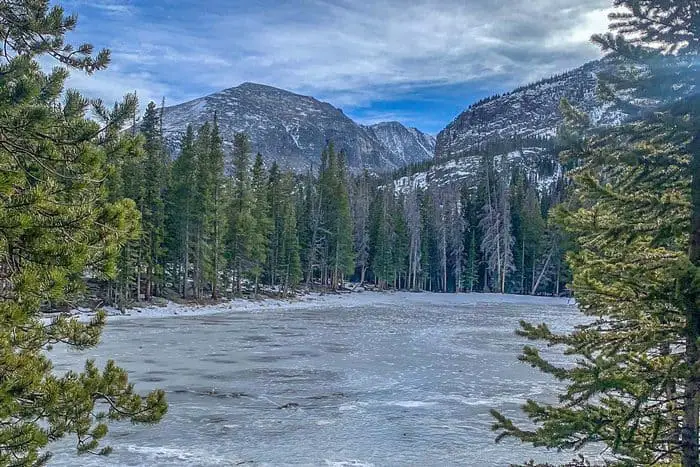
Emerald Lake Trail is one of the heavily trafficked trails in Rocky Mountain National Park. This trail features a lake and is located near Estes Park. You cover a total distance of 5.3 km round-trip and gain an elevation of 214m. The difficulty level is moderate. The best period to hike or snowshoe on this trail is between June and October.
Length: 3.2 mi
Elevation gain: 698 ft
Route type: Out & back
Kid friendly, Hiking, Snowshoeing, Forest, Lake, Partially paved, River, Views, Waterfall, Wildflowers, Wildlife, Rocky, Fee, No dogs

Rocky Mountain National Park Hiking Trail #2 – Bear Lake Nature Trail
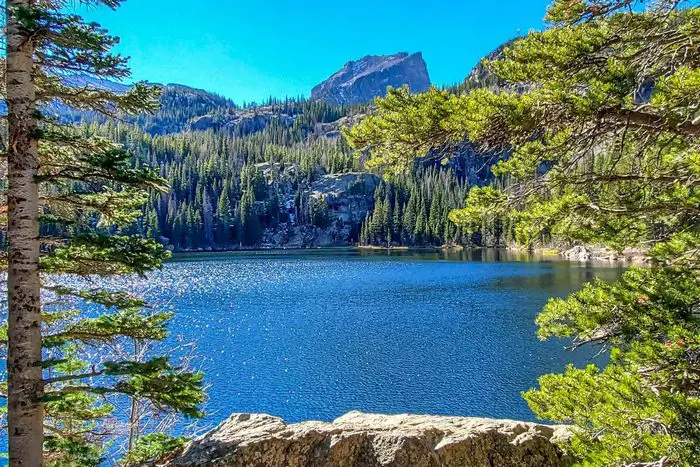
On this trail, you cover a distance of 1.1km round-trip where you gain an elevation of 15 meters hence rated as easy. It features a lake and best used between March and November mainly for hiking, snowshoeing, nature trips, and walking.
Length: 0.7 mi
Elevation gain: 49 ft
Route type: Loop
Kid friendly, Hiking, Snowshoeing, Walking, Forest, Lake, River, Views, Waterfall, Wildflowers, Wildlife, Rocky, Fee, No dogs

Rocky Mountain National Park Hiking Trail #3 – Sky Pond Trail Via Glacier Gorge
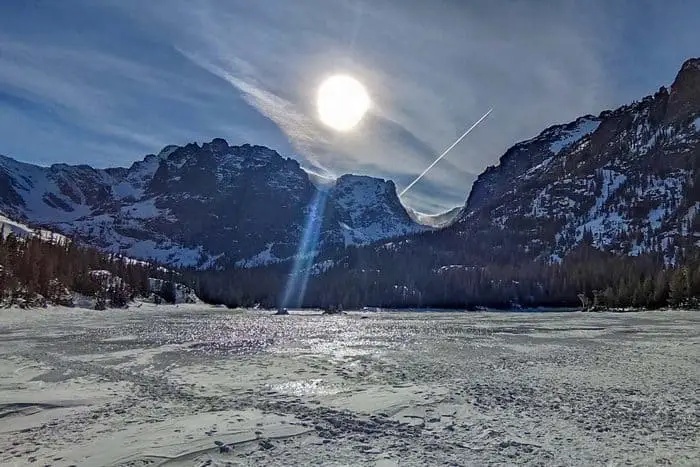
Sky Pond via Glacier Gorge Trail is 13.7 km long and you gain an elevation of 537 meters. It is rated as difficult and mainly used between June and October for hiking, snowshoeing, and nature trips.
Length: 9.4 mi
Elevation gain: 1,758 ft
Route type: Out & back
Hiking, Snowshoeing, Forest, Lake, River, Views, Waterfall, Wildflowers, Wildlife, Rocky, Scramble, Fee, No dogs
Rocky Mountain National Park Hiking Trail #4 – Twin Sisters Peak Trail
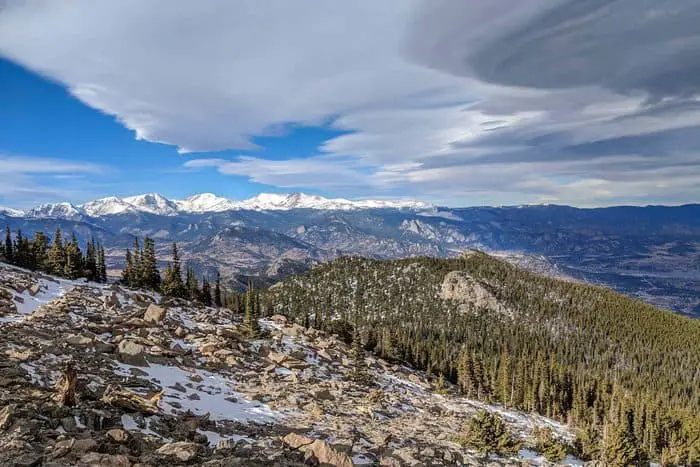
The distance here is 12.1 kilometers with an elevation gain of 767 meters. It is rated as difficult and best used between May and October primarily for hiking, snowshoeing, and horses. When you hike on this trail you have the chance to see wildlife.
Length: 7.5 mi
Elevation gain: 2,516 ft
Route type: Out & back
Hiking, Horseback riding, Snowshoeing, Forest, Views, Wildlife, Rocky, Fee, No dogs

Rocky Mountain National Park Hiking Trail #5 – The Lock Lake Trail through Glacier Gorge Trail
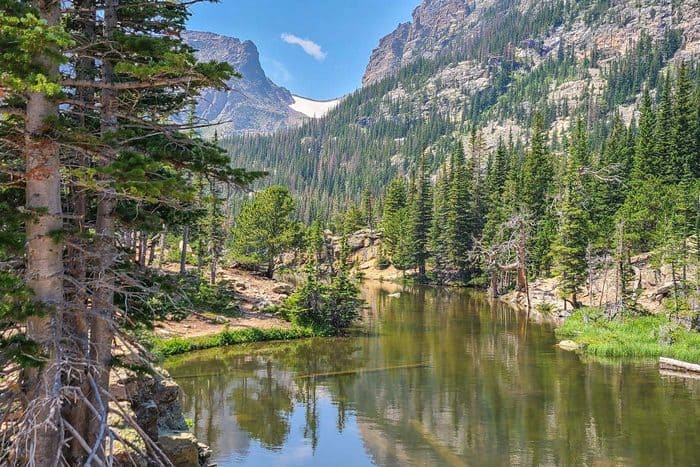
The distance cover on this trail is 8.7 kilometers with an elevation gain of 327 meters. It is rated as moderate and best used between March and October.
Length: 5.4 mi
Elevation gain: 1,056 ft
Route type: Out & back
Hiking, Snowshoeing, Bird watching, Running, Forest, Lake, Views, Waterfall, Wildflowers, Wildlife, Fee, No dogs

Rocky Mountain National Park Hiking Trail #6 – Deer Mountain Trail
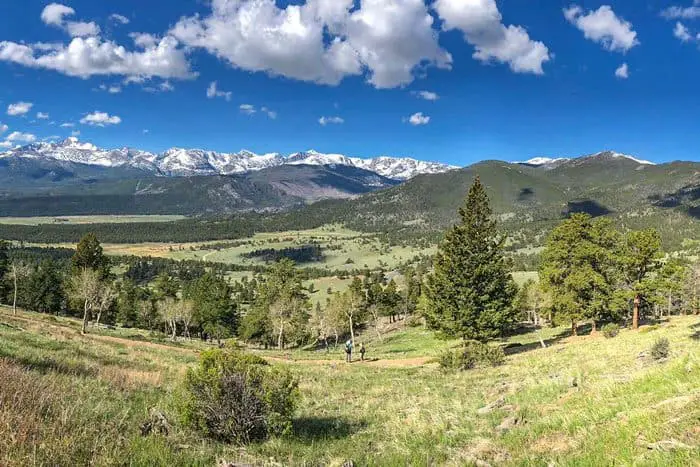
Deer Mountain Trail is 9.7 kilometers with an elevation of 427 meters hence rated as moderate. It features beautiful wildflowers and is mainly used for hiking. The estimated time to hike through this trail is 2 hours and 26 minutes.
Length: 6.0 mi
Elevation gain: 1,400 ft
Route type: Out & back
Hiking, Forest, Views, Wildflowers, Wildlife, Fee, No dogs

Rocky Mountain National Park Hiking Trail #7 – Gem Lake Trail

Gem Lake Trail is 5.5 kilometers long with an elevation gain of 302 meters hence rated as moderate. It features a lake and best used between May and October primarily for hiking. You need around 2 hours and 2 minutes round-trip on this trail.
Length: 3.1 mi
Elevation gain: 994 ft
Route type: Out & back
Hiking, Forest, Lake, River, Views, Wildflowers, Wildlife, Rocky, Scramble, Fee, No dogs

Rocky Mountain National Park Hiking Trail #8 – Alberta Falls Trail
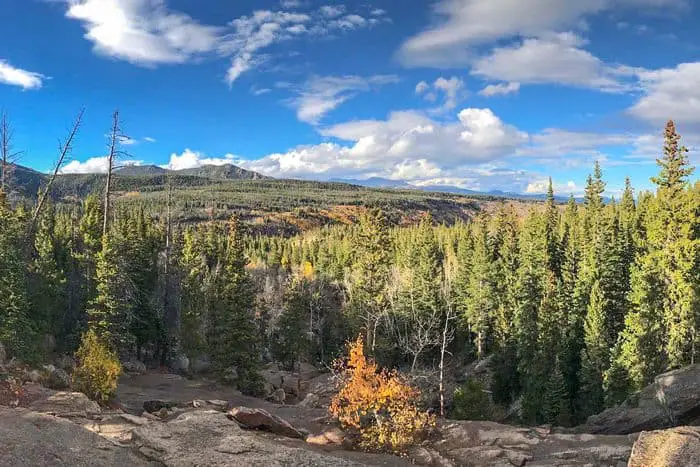
Alberta Falls Trail is a short distance of 2.6 kilometers with an elevation gain of 77 meters hence rated as easy. It features a waterfall and is best used between May and October for activities like hiking, horse riding, and birdwatching.
Length: 1.6 mi
Elevation gain: 232 ft
Route type: Out & back
Kid friendly, Hiking, Horseback riding, Snowshoeing, Walking, Running, Forest, River, Views, Waterfall, Wildflowers, Wildlife, Rocky, Fee, No dogs

Rocky Mountain National Park Hiking Trail #9 – Dream Lake Trail
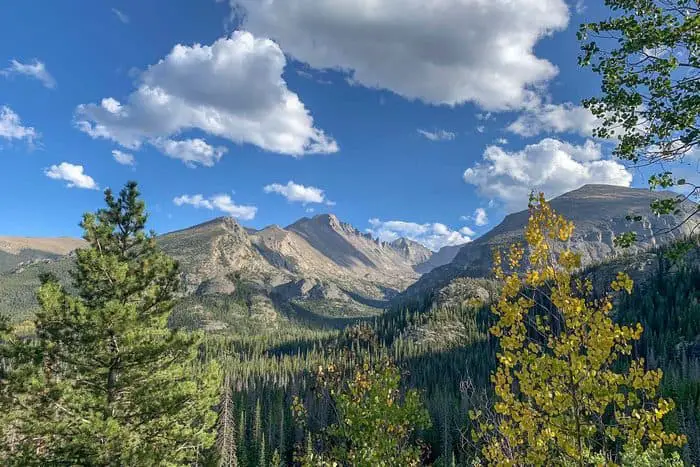
Dream Lake Trail is 3.2 kilometers with an elevation gain of 130 meters hence rated as easy. It features a lake and best used between April and November mainly for hiking and snowshoeing.
Length: 2.0 mi
Elevation gain: 426 ft
Route type: Out & back
Kid friendly, Hiking, Snowshoeing, Forest, Lake, Partially paved, Views, Wildflowers, Wildlife, Fee, No dogs

Rocky Mountain National Park Hiking Trail #10 – Chasm Lake Trail
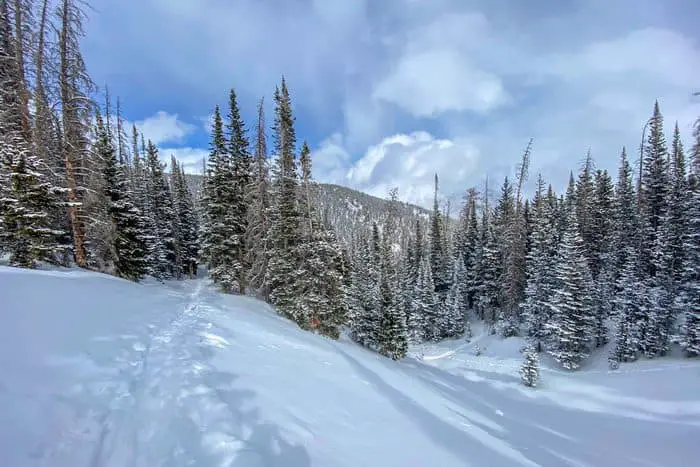
Chasm Lake Trail is 15.1 kilometers long with an elevation gain of 793 meters hence rated as difficult. It features a lake and is best used between June and October for activities like hiking horseback riding, rock climbing, and bird watching. For this hike, you take approximately 5 hours and 33 minutes.
Length: 8.8 mi
Elevation gain: 2,542 ft
Route type: Out & back
Hiking, Horseback riding, Snowshoeing, Forest, Lake, River, Views, Waterfall, Wildflowers, Wildlife, Rocky, Scramble, Fee, No dogs

How to Get To the Rocky Mountain National Park
To get to Rocky Mountain National Park, you will have to fly and land at Denver International Airport. You can then reach Estes Park in two different ways since there are no public means of transport to reach the park from the airport. The first means to reach Estes Park is to rent a car then drive yourself 80-something miles Northwest from the airport. The other option is to use Estes Park Shuttle and pay $85 for a round trip or $45 for a one-way.
The advantage of using a car to get to and around Rocky Mountain National Park is that you can come and go freely as you please. The advantage of using a shuttle is to get around the park is that you are taken around many routes and the main trails within Rocky Mountain National Park.
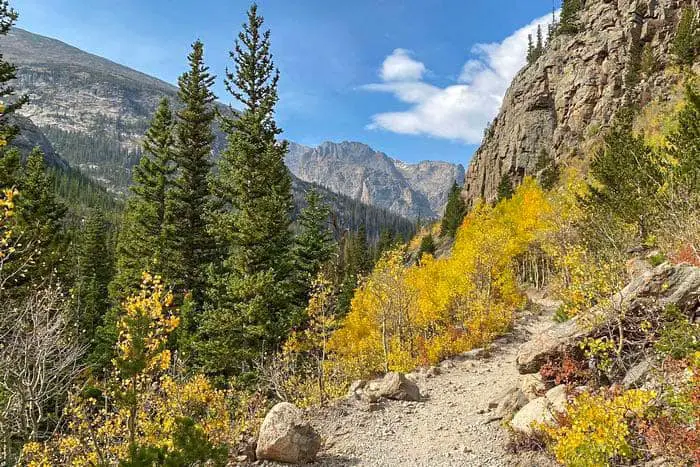
Rocky Mountain National Park – Where to Enter
1. Rocky Mountain National Park Boondocking Locations – East Entrance
The main entrances is on the east side of the park, located on highway 36 and 3.5 miles west of Estes Park, is the Beaver Meadows Entrance Station. This station, which is one mile west of the park’s headquarters and Beaver Meadows Visitor Center, usually receives the highest volume of visitors.
Serving visitors to the Wild Basin area of the park, approximately 19 miles to the south of Estes Park on highway 7, is the Wild Basin Entrance station.
2. Rocky Mountain National Park Boondocking Locations North Entrance
To the north of the Beaver Meadows area, located on highway 34 approximately four miles west of Estes Park, is the Fall River Entrance Station. This station is .25 miles from our newest visitor center, the Fall River Visitor Center.
3. Rocky Mountain National Park Boondocking Locations South Entrance
Serving visitors to the Wild Basin area of the park, approximately 19 miles to the south of Estes Park on highway 7, is the Wild Basin Entrance station.
4. Rocky Mountain National Park Boondocking Locations West Entrance
On the west side of the park, located approximately two miles north of Grand Lake, is the Grand Lake Entrance Station. This station is .25 miles north of the Kawuneeche Visitor Center near the beautiful Kawuneeche Valley.
Why Visit the Rocky Mountain National Park
Rocky Mountain National Park has great things ranging from beautiful rivers, mountains, stunning topography, and spectacular views that would make you spend your next vacation there.
One reason why you should visit this park is because of the Falls River Visitor Center which has naturally decorated exterior walls that make it a beautiful building in a spectacular place. This visitor center has a museum, restaurant, and Colorado-themed gift shop.
Secondly, the Bear Lake Trailhead that leads you to Nymph Lake, Dream Lake, and Emerald Lake is another reason to visit Rocky Mountain, National Park. Furthermore, the many retailers and restaurants in Estes Park town, as well as breweries, provide you with what you need as far as snacks, food, and drinks are concerned. These are great convincing reasons why your next vacation destination should be Rocky Mountain, National Park.
Our Top 10 Paid Camping Near Rocky Mountain National Park
The main campgrounds such as Aspenglen, Glacier Basin, Longs Peak, and Moraine Park around Rocky Mountain National Park are considerably affordable and hence making your tour there convenient. These campgrounds provide you with unique wilderness experiences whether you go there as a couple, group, or family despite their affordability. During the summer season, you are required to pay a camping fee of $26 per site in one night. On the other hand, during winter you are required to pay $18 per site since you are given a discount.
1. Aspenglen Campground
This is a major Rocky Mountain campground that is located close to the park’s Fall River Entrance. There are 52 sites here which are under Ponderosa Pines and you can easily access wildflower meadows from these sites. This campground opens between May and September and it offers restrooms, firewood, food lockers, water, and ice.
2. Morain Park Campground
Morain Park is another attractive campground option for you when you visit Rocky Mountain, National Park. It sits at an elevation of 8,160 feet and is Rocky Mountain National Park’s largest campground with 244 campsites. It offers restrooms, water, food lockers, and a dump station. Firewood and ice are on the other hand sold every season. It has an amphitheater to offer educational events to all visitors. It is usually open between May and October.
3. Estes Park Campground near Mary’s Lake
This campground is close to Rocky Mountain National Park with only a 7-minute drive. This campground is reasonably close to major area attractions. It has facilities such as laundry rooms, outdoor pool and hot water sink areas where you can wash our dishes.
4. Estes Park Campground near East Portal
This is a developed campground that offers stunning peak views of Rocky Mountain National Park. It has 66 campsites which have a picnic table, drinking water, firewood, fire ring, showers, and hookups.
5. Yogi Bear’s Jellystone Park
Yogi Bear’s Jellystone Park campground is mainly for young kids and families. It offers traditional amenities like a game room, pool, and playground. From this campground, you can easily have access to both the town and the parks in the vicinity.
6. Glacier Basin Campground
Glacier Basin Campground is quite a large campground within Rocky Mountain National Park. This campground has 150 sites and has become an excellent option for families and other campers alike. It ensures that your access to Rocky Mountain National Park is excellent. It has 13 group sites and four ADA fully accessible campsites that make it to be a very popular campground.
7. Longs Peak Campground
Longs Peak campground sits at 9500 feet making it the highest campground found at Rocky Mountain National Park. It has 26 tent-only sites and it is a great option for visitors looking for a remote camping experience because each site is secluded from the other sites in the campground.
8. Hermit Park
Hermit Park offers more than 100 tent sites and RVs. It also provides a camp store, seasonal firewood, water, and hookups for RVs. It is a very popular destination during the summer season since trails are easily accessible from this point.
9. Estes Park KOA Campground
Estes Park KOA campground sits at 7500 feet and is suitable for those who want to camp close to town. It has amenities such as a laundry facility, a pet park, an outdoor fire pit, showers, and a shuttle to take you to town.
10. Elk Meadow Lodge and RV Park
Elk Meadow Lodge & RV Park has resort-like amenities and is suitable for families. This campground has 7 cabins, more than 40 tent sites, and 169 RV sites which have full hookups. Furthermore, this campground has a playground, outdoor swimming pool, showers, mini-golf, hot tub, horseshoes, and many more.
Our Top 5 Thins to Do In Rocky Mountain National Park
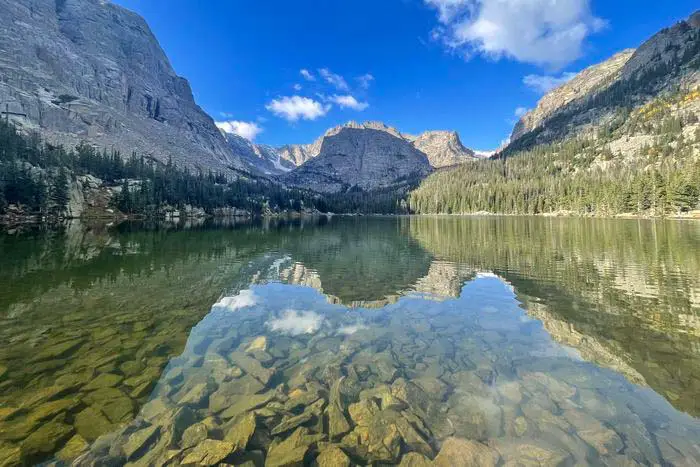
Hiking is one of the main things that you can do while at Rocky Mountain National Park so it is important to carry items needed to make this activity successful. Below are the must-do things when you visit Rocky Mountain National Park
1. Trail Ridge Road
Trail Ridge Road remains a must-do when you tour the Rocky Mountain, National Park. If you spend two hours to half a day in Trail Ridge Road, you will experience stunning views and see wildlife like the moose, elk, and marmots. As you do Trail Ridge Road, you can also make stopovers for spectacular photos. It is a drive of 48 miles from Estes Park to Grand Lake and it has offered a great sensation to travelers since it came into existence until today. However, you should be aware that the road usually has very low temperatures compared to Grand Park and Estes Park
2. Beaver Meadows Visitor Center
A stopover at Beaver Meadows Visitor Center is essential when you visit Rocky Mountain, National Park. In this visitor center or any other visitor center within the park, you are provided with the park’s educational overview. The park rangers in this Visitor center are very knowledgeable and helpful. They will advise you on the trails to take based on your skill level and the time that you will be in the park. At Beaver Meadows Visitor Center you will access books and maps about the park and also get walking sticks and other equipment that you do not have but are necessary. You can spend at least one hour here.
3. Bear Lake
When you make your way to Rocky Mountain National Park, Bear Lake is a must-visit for you. It is encircled by a trail of one mile and it is easy to hike with much beauty to see. This beauty is caused by aspens turning gold during fall and also fir, spruce, and pine trees that surround the lake. The trail surrounding Bear Lake will also enable you to have stunning views of Half Mountain and Hallett Peak. You can spend one to two hours in this place.
4. Morain Park Museum
When you tour Rocky Mountain National Park, a visit to the Morain Park Museum is a must-do activity for you. The museum offers you a lot to see such as the exhibits of the wildlife and geology found in the park. The museum also has an amphitheater where talks and events about the park are held. You can spend less than one here in this museum.
5. A visit to Downtown Estes Park
Estes Park is a home base and a gateway to many people who visit Rocky Mountain National Park and hence you must visit the town for your tour to look complete. Estes Park has a variety of accommodations ranging from hotels to Inns and Motels which offer you services at different prices. In this town, you will also find shops, restaurants, and bars for your food and drinks. One best thing about Estes Park is that the Thompson River cuts through the town and hence you find a Riverwalk where you can take a post-dinner stroll.
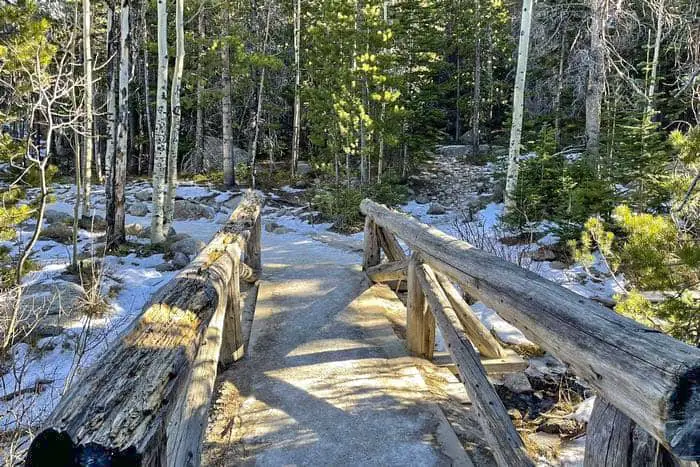
How Much Time Do You Need For Your Visit
It is not possible to explore Rocky Mountain National Park in one day or a few hours and exhaust everything. This is because the park is quite large and has a long list of interesting hikes that you need to explore. Ideally, for you to have ample time to drive through Old Fall River Road, Alpine Ridge Road and hike a couple of trails, you will need at least 3 days in this park. However, for avid hikers, five or more days are recommended in Rocky Mountain National Park. In the course of the five days as an avid hiker, you can tackle tougher and higher hikes like Hallet Peak, Longs Peak, and Mount Ida.
Accommodations and Dining Near the Rocky Mountain National Park
The night accommodation in Rocky Mountain National Park is not within the park itself but outside the park within the nearby towns; Estes Park and Grand Lake. There are plenty of hotels, cabins, and lodges in the park’s vicinity for your accommodation and dining. Hotels and accommodation facilities within Estes Park are better than those within Grand Lake because of the proximity to the park. Some of the lodges and restaurants in Estes Park include Alpine Trail Ridge Inn, Wildwood Inn, Estes Lake Lodge, Hotel Estes, and Murphy’s Resort, among many others. In Grand Lake, you can stay in places such as Gateway Inn & Conference Center, The Historic Rapids Lodge, The World’s End Brewpub, and many more.
Best Time to Visit the Rocky Mountain National Park
There are many factors to consider when planning for the best time of the year to visit Rocky Mountain, National Park. The park is usually open 24 hours a day throughout the year. One of these important factors is the roads you wish to drive and the exact spots you want to go within the park. For instance, Trail Ridge Road is usually closed between October and May. Another thing that you can consider is the crowds. For instance, the crowds are usually biggest during summer and fall weekends.
The type of activities you plan to do while in Rocky Mountain National Park is also an important consideration. Considering these factors, June to September is the best recommended time that you can visit Rocky Mountain, National Park. During this summer period, most of the hiking trails are accessible and the snow is melted. It is good to note that during this period the park is also crowded. If you need a little isolation, visit the park between October and May while wearing snowshoes.
Packing List for Rocky Mountain National Park
In Rocky Mountain National Park, there are about 300 miles of trails that you can hike through accompanied by stunning sceneries like waterfalls. To make your experience there enjoyable, convenient, and memorable, there are things that you should not forget to pack. Such things include but not limited to the following:
1. Strong pair of hiking boots: These are essential since most of the trails are full of rocks and pebbles and hence your hiking boots should be strong and waterproof, fit you well, and offer ankle support.
2. Plastic bag for collecting litters
3. Rain Jacket to protect yourself from afternoon storms
4. Binoculars for you to see distant wildlife, mountain peaks, and wildflowers
5. Enough water for your hydration and food for refueling your body
6. Hat and sunscreen to protect yourself from sunburn.
You May Want to Join Our Boondocking Group on Facebook For More Information
You May Want to Join Our Campfire Recipes Group on Facebook For More Information

